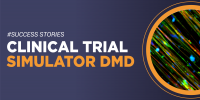Duchenne Muscular Dystrophy (DMD) is a severe genetic disorder causing muscle deterioration. Despite advances, no cure exists, and current treatments only slow progression. To support drug development, the FDA’s Critical Path Initiative and C-Path’s Duchenne Regulatory Science Consortium (D-RSC) launched a clinical trial simulation tool. This tool optimizes trials, supporting regulatory approval and speeding new therapies to market.

On January 19, 1932, Enzo Ferrari, the founder of Scuderia Ferrari, welcomed his first child, a son named Dino. At first, everything seemed normal for the future heir of the motorsport empire. But when Dino turned three, his parents noticed that he struggled to run, jump, and keep up with his friends. He also started falling more frequently. Concerned, they took him to a doctor, and it was then that they received a heartbreaking diagnosis: Dino had Duchenne Muscular Dystrophy (DMD).
DMD is a severe genetic disorder caused by a mutation in the gene responsible for producing dystrophin, a protein essential for muscle strength and stability. Without functional dystrophin, muscles gradually deteriorate, affecting movement, breathing, and heart function. This condition affects roughly one in every 5,000 newborns, primarily boys. By around age 20, most will require ventilatory support, and the disorder often proves fatal a few years later, as it did for Dino Ferrari.
Over the last century, there have been significant advances in understanding DMD, but no cure has been found. Current treatments can only slow the progression of the disease, and the approval of new therapies is challenging due to the small patient population, the young age of those affected, and the late diagnosis, which complicates drug development and approval.
To address such challenges of rare diseases, the U.S. Food and Drug Administration (FDA) launched the Critical Path Initiative (CPI) identifying opportunities to improve the accuracy of tests that predict the safety and efficacy of potential medical products. Amongst others, Critical Path Institute (C-Path), a non-profit public-private partnership creates tools and methods that overcome the barriers in the critical path of drug development (e.g. clinical trials), to advance treatments for patients worldwide, including those suffering from rare diseases like DMD.
C-Path has led a global collaboration through the Duchenne Regulatory Science Consortium (D-RSC), to create a computer model based on the patient-level clinical data from DMD studies. This resulted in a dedicated clinical trial simulation tool for DMD, which can help define an optimal design for real clinical trials.
Recently, the European Medicines Agency issued a Letter of Support to encourage further development of this tool, which is also being actively reviewed by the FDA. This cutting-edge model doesn't replace traditional clinical trials themselves, but allows scientists to simulate the possible sources of variability at baseline, like age, genetic mutations, and dropout of individuals with DMD. Moreover, it incorporates a longitudinal disease progression model, increasing the regulatory acceptance of potential DMD treatments.
Such a computer-based simulator enriches the design of real clinical trials and mitigates issues connected to small population size, long trial duration and limited statistical power that block the path of treatment development for rare diseases like DMD. Thus, not compromising the ability to assess a prospective therapy’s effectiveness and allowing new therapies to reach the market faster.
Finally, to enhance support for patients and families affected by rare diseases and to accelerate the development of new therapies for Duchenne Muscular Dystrophy, it is possible to contribute to the D-RSC consortium with additional patient-level data here.
Further resources: